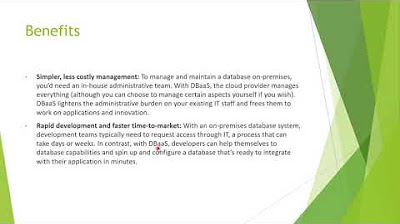Cyber Security Pada Cloud Platform. Part 01
Summary
TLDRIn this podcast, the hosts discuss security aspects of cloud infrastructure, focusing on how cloud services protect customer data. They compare on-premises setups with cloud environments, explaining the shared responsibility model where both the provider and the customer play a role in security. Key concepts like confidentiality, integrity, and availability are introduced, alongside practical approaches for securing cloud environments, such as antivirus software and intrusion prevention. The conversation also touches on the flexibility of cloud security solutions and how security services help protect data, emphasizing the importance of comprehensive security layers.
Takeaways
- 😀 Cloud security involves protecting customer data and infrastructure hosted in the cloud, just like on-premise infrastructure.
- 😀 There is a shared responsibility model between cloud service providers and customers for security, with specific areas being the responsibility of each party.
- 😀 Security concepts like confidentiality, integrity, and availability are key pillars in ensuring overall security for cloud services.
- 😀 Cloud providers offer infrastructure, but customers must still install their own security measures such as antivirus software on their servers and data.
- 😀 The difference between on-premise and cloud infrastructure lies in physical server management and the level of control customers have over security configurations.
- 😀 For cloud services, customers need to be aware of how to protect their data, whether it's shared or dedicated, and apply proper security measures accordingly.
- 😀 In cloud environments, security certifications provided by vendors assure that data centers are secure, but customers are still responsible for securing their own data within the service.
- 😀 The security measures for cloud-based services can include various protections such as anti-malware, intrusion prevention, machine learning, and application control.
- 😀 Customers must understand the level of responsibility they have in cloud security, including ensuring the protection of their data and employing necessary security tools.
- 😀 Cloud service providers typically offer enhanced security layers, but additional protection such as endpoint security, intrusion detection, and incident response must be configured by customers for full security.
Q & A
What are the main topics discussed in this podcast?
-The podcast focuses on cloud security, comparing it with on-premise infrastructure security, and discussing how cloud service providers implement security standards and responsibilities.
What is the difference between on-premise and cloud infrastructure security?
-On-premise infrastructure security requires the customer to manage physical servers, install antivirus, and handle networking security. In the cloud, the infrastructure is provided by the cloud service provider, but the customer still needs to manage certain security aspects, like server and data protection.
What is the shared responsibility model in cloud security?
-The shared responsibility model means that cloud service providers handle certain security aspects, such as physical security and the infrastructure, but customers are still responsible for securing their data, applications, and other elements within the cloud environment.
How does the security responsibility differ between on-premise and cloud environments?
-In on-premise environments, customers are entirely responsible for securing their infrastructure, including hardware, software, and networks. In cloud environments, the responsibility is divided; the provider secures the infrastructure, while customers handle security for their data and applications.
What is the importance of confidentiality, integrity, and availability in security?
-Confidentiality, integrity, and availability are key components of security. Confidentiality ensures that only authorized users can access data, integrity ensures that data remains unaltered and accurate, and availability ensures that data and services are accessible when needed.
Can customers install their own security solutions in cloud environments?
-Yes, customers can install their own security solutions such as antivirus or firewalls in cloud environments, depending on the service model they are using. For example, in Infrastructure-as-a-Service (IaaS), customers have more control over security compared to Software-as-a-Service (SaaS).
How are security measures implemented in cloud environments compared to on-premise?
-In cloud environments, the security measures are often integrated by the provider, offering more flexibility and scalability. However, customers still need to configure and manage security for their specific data and applications. In on-premise environments, customers must configure and manage all aspects of security themselves.
What are some common cloud security features available to customers?
-Some common cloud security features include anti-malware, intrusion prevention systems, application control, machine learning for threat detection, and incident detection and response systems.
What role do security certifications play in cloud security?
-Security certifications, such as ISO 27001 or SOC 2, are critical in ensuring that a cloud service provider meets industry standards for security. These certifications give customers confidence that the provider's infrastructure is secure and complies with best practices.
What is the importance of additional security layers like multi-factor authentication in cloud environments?
-Multi-factor authentication and additional security layers are important to further protect user accounts and data from unauthorized access, especially in cloud environments where various threats can target both the infrastructure and user applications.
Outlines

This section is available to paid users only. Please upgrade to access this part.
Upgrade NowMindmap

This section is available to paid users only. Please upgrade to access this part.
Upgrade NowKeywords

This section is available to paid users only. Please upgrade to access this part.
Upgrade NowHighlights

This section is available to paid users only. Please upgrade to access this part.
Upgrade NowTranscripts

This section is available to paid users only. Please upgrade to access this part.
Upgrade Now5.0 / 5 (0 votes)





